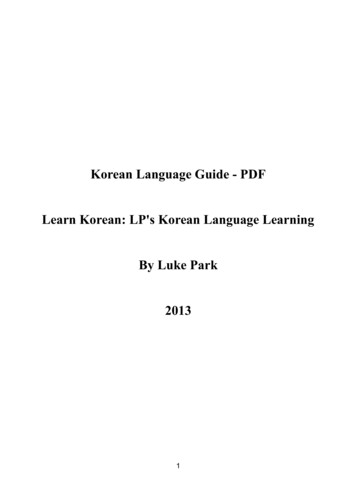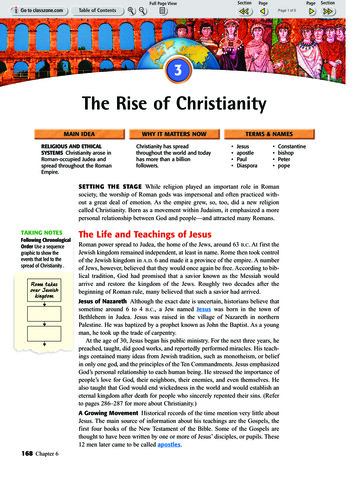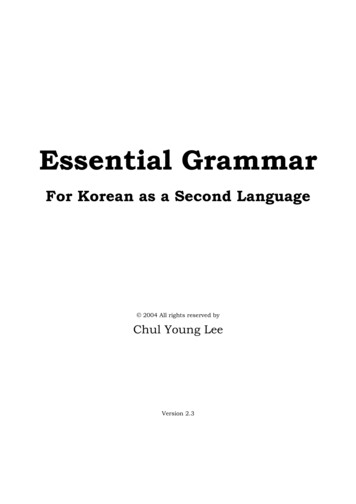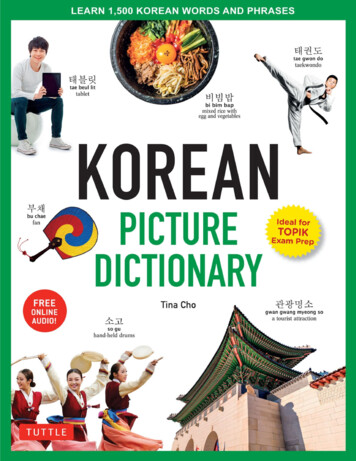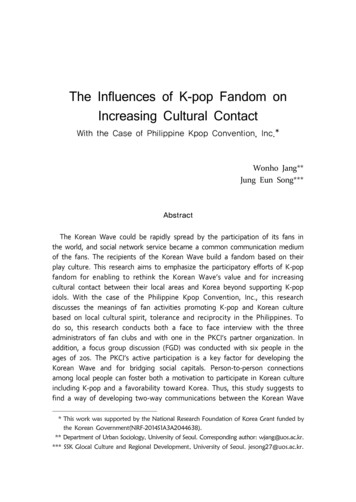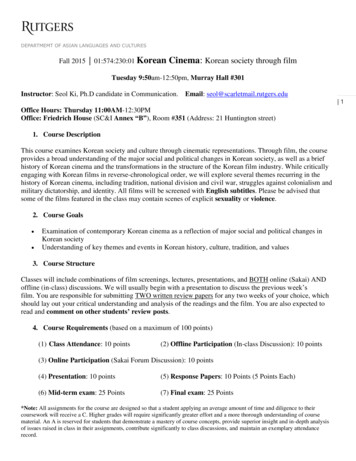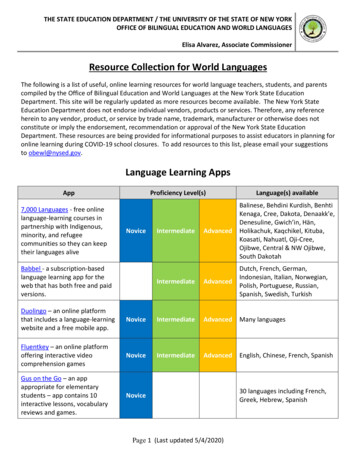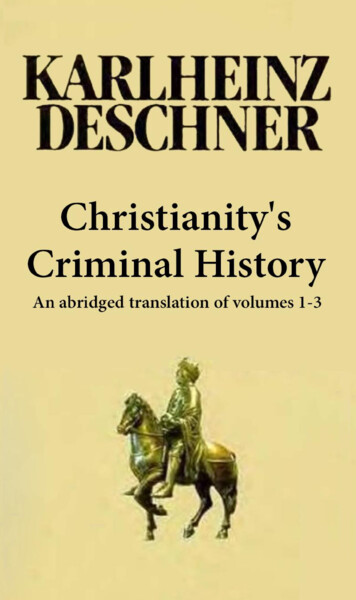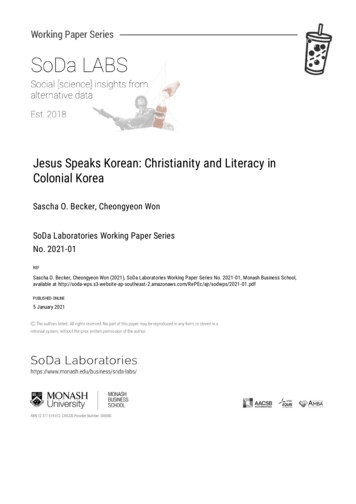
Transcription
Jesus Speaks Korean: Christianity and Literacy inColonial KoreaSascha O. Becker, Cheongyeon WonSoDa Laboratories Working Paper SeriesNo. 2021-01REFSascha O. Becker, Cheongyeon Won (2021), SoDa Laboratories Working Paper Series No. 2021-01, Monash Business School,available at s.com/RePEc/ajr/sodwps/2021-01.pdfPUBLISHED ONLINE5 January 2021
Jesus speaks Korean:Christianity and Literacy in Colonial KoreaSascha O. Becker and Cheongyeon Won*5 January 2021Forthcoming in the special issue “Literacy and Development”of the Rivista di Storia EconomicaAbstractIn the mid 19th century, pre-colonial Korea under the Joseon dynasty wasincreasingly isolated and lagging behind in its economic development. Joseon Koreawas forced to sign unequal treaties with foreign powers as a result of which Christianmissionaries entered the country and contributed to the establishment of privateschools. We show that areas with a larger presence of Christians have higher literacyrates in 1930, during the Japanese colonial period. We also show that a highernumber of Protestants is associated with higher female literacy, consistent with astronger emphasis on female education in Protestant denominations.Keywords: Literacy, Religion, Missionaries, Gender gap, Korea.JEL Classification: I21; N35; Z12; J16.*We thank Rachel McCleary, as well as colleagues at SoDa Labs, and three anonymous referees for comments. We thank JiYeon (Jean) Hong and Christopher Paik for kindly sharing the data from their 2018 EHR paper and Yi-Taek Park for sharingthe market size data from his 2020 KEHR paper. Jonghyuk Kim kindly shared shape files from 1930 with us. Support by theESRC Centre for Competitive Advantage in the Global Economy (ESRC grant ES/L011719/1) is gratefully acknowledged.Becker: SoDaLabs @ Monash U and U Warwick, CAGE, CEPR, CESifo, Ifo, IZA and ROA, Postal address: 900 DandenongRd, Building H, room 4.54, Caulfield East VIC 3145, Australia (email: sascha.becker@monash.edu); Won: SoDaLabs @Monash U, Postal address: 900 Dandenong Rd, Building H, room 4.54, Caulfield East VIC 3145, Australia (email:cheongyeon.won@monash.edu)1
1. IntroductionIn modern economies, more educated people typically earn more (see Card 1999). Thereason why education might have pecuniary payoffs is explained by human capital theory. Thekey idea is that education is an investment which yields higher labour-market earnings because itincreases productivity (Becker 1967). There is a substantial body of work showing that humancapital mattered for economic development, in different European countries, in different periods,even before modern times.1 Similarly, a rapidly growing literature studies the role of missionariesfor economic development around the world.2 In East Asia, for instance, Bai and Kung (2015)find that Chinese regions that had higher penetration of Protestant missionaries during the 19thcentury also had higher urbanization rates at the beginning of the 20th century.3 In South America,Valencia Caicedo (2019a) shows the persistent effect of Jesuit historic missions on education andincome today. Given the role attributed to education in economic development, it is important tounderstand the historical roots of educational achievement.We examine the roots of regional differences in literacy in colonial Korea, specifically in theyear 1930. The roots of schooling accessible to broader parts of the population are largely theresult of “globalization” in the form of Korea’s opening up to the outside world in the late 19thcentury (see Cappelli and Mitch, 2019, for the role of “globalization” in the rise of masseducation). A push towards education resulted both from the arrival of Christian missionariesduring the late 19th century (McCleary, 2013) and from public schooling instituted duringJapanese colonial times (Hong and Paik, 2018). Go and Park (2019) note that the rise of masspublic schooling at the elementary level Korea was notable, compared with the experience ofother colonies in Southeast Asia, South Asia and Africa (Chaudhary 2009; Frankema 2012, 2013;Chaudhary and Garg 2015). While school enrolment was far from universal even at the end ofJapanese rule in 1945, the foundation was laid for a continued development in public education1Meisenzahl and Mokyr (2012) highlight the role of technical competence, as a key factor in Britain’s economic leadership.Kelly, Mokyr and O'Grada (2014) point to the importance of human capital (broadly defined) and the quality of the Britishlabor force on the eve of the Industrial Revolution. De Pleijt (2018) shows that, in England, human capital facilitated preindustrial economic development. Squicciarini and Voigtlaender (2015) show that upper-tail human capital, proxied by thehistorical presence of knowledge elites mattered for industrialization in France. Cinnirella and Streb (2017) analyze the role ofhuman capital and innovation in economic development, using Prussian data. Dittmar and Meisenzahl (2020) document thatGerman cities that formalized public goods provision (Protestant church ordinances stipulating schooling) in the 1500s beganto differentially produce and attract upper tail human capital and became significantly larger in the long-run.2See Woodberry (2011) for an early survey on the literature on missionaries. The literature on missionaries and education ismore extensively covered in recent surveys for Africa by Meier zu Selhausen (2019) and for Latin America and Asia byValencia Caicedo (2019b).3Even earlier, between 1580 and 1780, the Jesuits introduced Chinese literati to Western scientific thought (Ma, 2020).2
in Korea after independence, and arguably contributed to the dramatic economic growth of(South) Korea after WWII.While the role of Christian missionaries has been stressed before, we are not aware of aformal regression analysis that studies the relative role of Christian missionaries, compared toother actors in fostering schooling and literacy. Before 1884, Korea only had quite a small numberof Christians. Virtually all of them were “crypto”-Catholics, going back to Jesuit missionaries inChina whose books were read in Korea (Rausch, 2017). In pre-colonial Korea, under the Joseondynasty, there were several waves of persecution of Catholics, in 1839 (Ki-hae persecution), 1846(Pyong-o persecution) and 1866 (Pyong-in persecution). Overall, there were 10,000 martyrs. In1866, only 20,000 Catholics were left. In 1884, Korea opened up to the outside world. As a result,Presbyterian and Methodist Episcopalian missionaries engaged in medical and educational work.Several Korean scholars have attributed to the mainline Protestant missions, particularly theMethodists, the country’s modern curriculum and high literacy rates (Lee 1989; Park 2000).However, there are few empirical studies of literacy rates in colonial Korea, Hong and Paik(2018) being the notable exception.4 However, the focus of their work is on pre-colonial elites.More specifically, they investigate how the civil exam system and scholarly traditions in precolonial times interact with the provision of public schools under Japanese colonial rule, toinfluence levels of literacy in colonial Korea. Their key finding is that Korean literacy was higherduring the early colonial period in areas where before colonization more people (elites) had passedthe civil service exam. This result is explained by the role those elites played in establishingprivate schools as alternatives to the colonial public schools.In this paper, we build on this earlier work, and add data on the presence of three groups ofreligious players: Christian priests, Buddhist monks and (Japanese) Shin-to priests. Ourhypothesis is that Christian ministers made a positive contribution to Korean literacy, boththrough their role in running (private) missionary schools (Go and Park, 2019), but also viainformal night gatherings and educational activities by Christians (Noh, 1975, and Han, 1997).5Buddhist monks and Shin-to priests, in contrast, were not involved in similar educationalactivities.4Go and Park (2019) compare public schooling in Taiwan and Korea, which were colonized by Japan in 1895 and 1905,respectively. Using aggregate data, they show that the Korean public schooling system developed more slowly, as a result ofweaker school financing.5Han (1997) mentions a total of 808 evening study groups (yahak) across Korea.3
It is important to note that while, at the end of the 19th century, Western Christianmissionaries were the starting point for broader Christianization efforts, in the sequel Koreanswere ordained as priests. In 1932, there were 2,552 Christian priests across Korea, of whom 341were Western missionaries from the U.S., the U.K., France, Germany, etc. (Chōsen GovernmentGeneral, 1932). In other words, the vast majority of Christian ministers were locals.6 Missionarywork thus was a joint effort between Western ministers and locals.The contribution of Protestant churches to literacy was not only through the regular day-timeschools, but also through informal channels: Protestant churches provided night study groups andwere also major providers of Hangul Kansupso (schools teaching Korean) such as “sodang”(which were originally traditional Confucian schools), and summer schools for children. Thesekinds of institutions were mainly operated by native Korean Christians. The curriculum of theseinstitutions usually included reading and writing the Korean and Japanese languages, and basicmathematics. According to Han (1997), there were 17,544 night study groups in 1929, 11,375sodang in 1932, and 952 summer schools for children in 1932 across the Korean peninsula,respectively. This extensive education activity of Christians supported an increase in literacy inKorean and Japanese.7Buddhism was introduced to Korea from China at A.D 372.8 However, the goal of the Joseondynasty that ruled Korea before the colonial period, was to promote Confucianism and hencelargely suppressed Buddhism. This explains why there was a low number of Buddhists in Koreain the colonial period despite a long history of Buddhism in Korea. After Japan annexed Korea,the Chōsen Government-General tried to reform Korean Buddhism into a system similar toJapanese Buddhism. In particular, the Chōsen Government-General issued the Temple Ordinancein 1911 to control Buddhism in Korea, by allowing the Japanese government to directly overseethe 30 main temples in Korea. (Sørensen, 1997) As a result, it is presumed that all Buddhist monkswere Korean or Japanese during the colonial period.As we will show, the vast majority of Koreans, in 1930, remained Confucian, so were neitherChristian, nor Buddhist, nor believers of Shin-To (followers of the Japanese Shin-to faith).Confucianism is often characterized as a system of social and ethical philosophy rather than a6This is a development similar to the one stressed by Jedwab, Meier zu Selhausen, and Moradi (2019) for Africa, namely thatlocals constituted the vast majority of Christian ministers after the onset of missionary activities.7Some of the early Western missionaries, e.g. John Ross and John McIntyre, two Scottish Presbyterian missionaries,commanded the Korean language and initiated the Korean translation of the Bible (Kim and Kim, 2015), but given the largenumber of Korean ministers, it was not essential for education to succeed.8See http://afe.easia.columbia.edu/tps/300ce ko.htm#buddhism (accessed 26 Sep 2020).4
religion. Following this logic, statistics of the Chōsen Government-General only list Christians,Buddhists and Believers of Shin-To as followers of a religion.Cheondoism was also a religious group at the time. Many believers of Cheondoism wereinvolved in the independence movement in the Korean peninsula during the colonial period (Kim,2016). But the Chōsen Government-General did not officially recognize Cheondoism as areligious group, which is why it is almost impossible to obtain reliable data regarding believersof Cheondoism. As a result, we focus on the three major religious groups described earlier, forwhich official statistics exist. Using data on the presence of ministers of these three faiths, as wellas data on believers of those same faiths, we show a link between the number of Christians and(higher) literacy rates. While our focus is on literacy in the Korean language, we also considerliteracy in Japanese and/or both languages.We also look at literacy by gender, demonstrating that literacy rates are higher for bothgenders in areas with a larger number of Christian ministers (and believers). Using data on theshare of Catholic and Protestant ministers at the province level, we can see whether literacy ratesvary by gender depending on the share of Catholic and Protestant ministers. In line with patternsobserved at the country-level in 1970 (see Becker and Woessmann, 2008), as well as at the countylevel in 19th century Prussia (see Becker and Woessmann, 2008), areas with a larger share ofProtestant ministers had higher literacy rates for females, i.e. there is more egalitarian educationalachievement across genders in those areas.We want to stress that we consider our analysis as explorative. We do not claim a causal linkbetween Christianity and literacy, although we do attempt to control for a multitude ofconfounding factors. A causal analysis is left for future research that will further explore thelocation choice of Christian missionaries and the spread of Christianity in pre-colonial andcolonial Korea.The paper is organized as follows. The next section introduces our data, section 3 presentsresults and section 4 concludes.2. DataMost of the data we use is published at the level of the 234 counties of colonial Korea. Somedata is only available at the level of 13 provinces, as pointed out below.Our key outcome variable is literacy. The Japanese colonial census published by the “Chōsen”Government-General (“Chōsen”: Japanese name of Korea) covers Korean and Japanese residents5
and includes county-level data on the number of people literate in Korean, Japanese, bothlanguages, and neither language in 1930. In our main specifications, we use the literacy rate inKorean (i.e. being literate either Korean alone or Korean & Japanese), as Hong and Paik (2018),but we also look at the literacy rate (a) in Korean only; (b) Japanese only and (c) in Japanese(either Japanese alone or Korean & Japanese). Furthermore, the census provides literacy status bygender.Given our interest in the role played by Christian ministers and clergy of other religions, wecollect county-level data from the 1930 census taken by the Chōsen Government-General. Thecensus classifies occupations in 1930 into 337 groups, among which are three major religiousoccupations: Christian priests, Buddhist monks, and Japanese Shin-to “Japanese Shin-To priests”,the latter mostly serving Japanese immigrants (“colonizers”).Moreover, “the Report on Religion in Korea” (Chōsen Government-General, 1932)provides province-level data on the number of believers of the three major religious groups.Assuming that the number of believers per clergyman is the same across counties within the sameprovince, we can obtain the total number of believers of religion r at the level of county c asfollows:# # %&'( )* &% ' ), & , #)-,.( # # 2% %0%&3 )* &% ' ), & , /&)0 ,#% /# # %&'( )* &% ' ), & , /&)0 ,#% /Based on the number of believers of religion r, we can compute their population shares.The “Report on Religion in Korea” also provides the number of priests by Christiandenomination at the province level. Using the number of Catholic and Protestant priests at theprovince level, we impute the number of Catholic and Protestant priests at the county level,assuming that their ratio across counties within the same province is identical.We collect data on elementary schools and teachers for public, private and mission schoolsat the province level in 1930, from the “Statistical Yearbook of the Chōsen Government-General”(hereafter “Yearbook”). The Yearbook was published annually during the colonial period in Korea.Given that county-level literacy data are available only for 1930, we exploit the yearbook of 1930to verify the relationship between schools and literacy rates.We also employ data kindly shared by Hong and Paik (2018) on those passing civil serviceexams under the pre-colonial Joseon dynasty from their historical court examination archives.Their data not only covers the number of exam passers, but we also exploit control variables theyused such as the percentage of the workforce in non-agricultural occupations, the land tenancyratio, soil acidity, distance to Seoul and population density.6
Furthermore, we use data on market size during colonial period, kindly shared by Park (2020),as well. 9 This data contains the volume of market transactions at the town level in 1928, 10denominated in Japanese Yen. We aggregate town level to the county level. Market size is a proxyfor the development of a local market economy.We start with descriptive statistics. Table 1 shows that literacy rates were low in 1930 byWestern standards at the time. About 22 percent of the population were literate in Korean, whichcomprises 15.2% who were literate in Korean only and 6.7% who were literate in both Koreanand Japanese. 8.5% were literate in Japanese, which comprises 1.7% who were literate in Japaneseonly and the same 6.7% who were literate in both languages. Also notice the substantial variationacross counties in literacy. For instance, the literacy rate in Korean varies between 11.6 and 43.7percent across counties. Note that the literacy rate is computed relative to the whole population.If we had data on age composition in the 1930 census, we could compute it relative to a populationof those above a certain age and would mechanically find a higher literacy rate. With thisadjustment in mind, the Korean literacy rates seems to roughly compare with those in Italy 70years earlier. The (adult) literacy rate in Italy at the time of unification in 1861 was 27% andaround 35% in 1871. The literacy rate in Spain was around 30% by 1870 (Cipolla, 1969).11 Forcomparison, already in 1871, average literacy rates for those aged 10 and above, even in ruralmanors (the smallest administrative units with an average size of 126 people) in Prussia were 73%(Becker and Cinnirella, 2020).Turning to religion variables, we measure the presence of Christian priests, Buddhist monksand Japanese Shin-To priests per 1,000 inhabitants. While some counties have no presence ofeither Christian, Buddhist or Japanese Shin-To priests, others have a substantial number per 1,000inhabitants. For instance, Wonsan county has 1.684 Christian priests per 1,000 inhabitants,12Yangsan county has 5.755 Buddhist monks,13 and Suncheon county has 1.5 Japanese Shin-Topriests,14 with the averages across all counties being 0.1 (Christian), 0.35 (Buddhist) and 0.034(Japanese Shin-To priests) per 1,000 inhabitants, on average, across Korean counties.9We thank a referee for suggesting the use of this data.For instance, in the county of GoYang-Gun, there are 12 towns, only one of which (Jung-Myeon) has a physical marketplace whose transaction volume is captured in the data.11Ciccarelli and Weisdorf (2019) provide regional literacy rates by gender for Italy during the 19th century.12Wonsan is known for its many Christian monasteries and churches.13Yangsan has a long history in Buddhism, featuring Tongdo Temple, one of the largest temples in Korea. Since Buddhisttemps are usually located in mountainous areas and deep valleys, the number of Buddhist monks tends to be higher in ruralareas.14Suncheon is at the Southern tip of South Korea, across from Japan.107
Noticeably, Korea being strongly Confucian from pre-colonial times, the share of believersin Christianity, Buddhism and Shin-to was low. On average, 2.75% were Christians, 2.56% wereBuddhists, and 0.13% were believers of Shin-To. Daegu has an imputed share of Christians of21.5% in the total population, Yangsan has an imputed share of 11.6% who are Buddhist, andKyungsung county (the county comprising Seoul) has 8.6% who are believers of Shin-To.Remember that, since the number of believers is only available at the province-level, we assumea uniform distribution of believers per priest across counties in the same province, an assumptionwe cannot test and which may amplify some numbers. It is for this reason that we focus on thenumber of priests (measured at the county-level to begin with) in most of our tables, and onlyshow results using the (imputed) share of believers in one regression table (Table 3). To furtherprobe robustness of the use of the share of believers, Appendix Table A.2 uses the actual provincelevel share of believers across different groups instead of the (imputed) county-level ones. AsTable 1 shows, using province-level data on the share of Christians, Buddhists and believers ofShin-To, we find average values of 1.79 (max 4.30%) for Christians, 0.49% (max 1.56%) forBuddhists and 0.34% (max 1.81%) for believers of Shin-To. Regression results are very similarwhen using province-level variables, alleviating worries that high imputed values might drive theresults in Table 3.Furthermore, we use province-level data on the number of public, (non-Christian) privateschools, and missionary schools when trying to understand whether presence of Christianministers (missionaries and local Korean priests) mainly affect literacy via the presence ofmissionary schools, or whether even controlling for the presence of schools of different types,literacy is affected, as suggested by the existence of night study groups that were far morenumerous than missionary schools.Finally, we use a rich set of additional variables. A key variable is the number civil exampassers (per 1,000 inhabitants), which is the focus of the analysis in Hong and Paik (2018). Thisvariable captures the influence played by local elites in supporting education efforts during thecolonial period. We will show that, throughout, this variable is an important predictor of literacy,thus confirming Hong and Paik (2018), while at the same time pointing to an additional effect ofthe presence of Christian ministers in fostering education. Additional control variables from Hongand Paik (2018) are the population share of Yangban (the upper social class) in 1909, as well asthe percentage employed in non-agricultural occupations and population density to measureeconomic development, distance to Seoul, the capital of colonial Korea, the land tenancy ratio,8
which Hong and Paik (2018) expect to positively influence the literacy rate because of itsrelationship with past achievements in civil exam examinations. Finally, soil quality is proxied bysoil acidity, as soil quality is correlated with the population share of the elite (Hong and Paik,2018). We use the same set of control variables not as a matter of convenience, but to ensure thatwe replicate important earlier research before complementing it with our analysis on the role ofreligion. Following the suggestion of a referee, we only go beyond the set of controls in Hong andPaik (2018) in one respect. We use market size per capita from Park (2020) to measure thedevelopment of a local market economy. Yet, in Table A.1, we show that, when using exclusivelythe Hong and Paik (2018) variables, we replicate their results.[Table 1] Descriptive riableKorean Literacy Rate (Both OnlyKorean)Japanese Literacy Rate (Both OnlyJapanese)Koran Literacy Rate (Only Korean)Japanese Literacy Rate (Only Japanese)Korean and Japanese Literacy Rate (Both)No. of Priests (Christianity) per 1,000No. of Monks (Buddhism) per 1,000No. of Japanese Shin-To Priests per 1,000Share of ChristiansShare of BuddhistsShare of Shin-To believersShare of Christians [Province]Share of Buddhists [Province]Share of Shin-To believers [Province]No. of Public Schools per 1,000 [Province]No. of Private Schools per 1,000 [Province]No. of Missionary Schools in per 1,000[Province]No. of Passer (Civil Exam) per 1,000Yangban (upper social class) share (1909)Non-Agricultural Occupation (%)Population density (1,000 people/km2)Market Size per Capita (Japanese Yen)Log Market SizeDistance to Seoul (km)Land tenancy ratioSoil acidityObs.MeanStd. 121.000642.637.8085.000Note: Variables refer to 1930, unless otherwise noted. Variables are measured at the county level unless otherwise noted.Source: Variables in Literacy rate and Religions are based on the Census in Chōsen in 1930. Variables is schools are from theStatistical Yearbook of the Chōsen Government-General in 1930. Controls variables are from Hong and Paik (2018) and Park(2020).9
[Figure 1] Literacy in Korean and the Number of Christian priests in 1930PyongyangSeoulMap source: Historical shape file created by Dr Jonghyuk Kim, who kindly shared it with us.Data source: The Census in Chōsen in 1930.[Figure 2] Number of missionary schools [province level].PyongyangSeoulMap source: Historical shape file created by Dr Jonghyuk Kim, who kindly shared it with us.Data source: Statistical Yearbook of the Chōsen Government-General in 1930.10
Figures 1 and 2 show the geographic distribution of some of our key variables of interest.Figure 1 shows that the North not only had higher literacy rates than the South, but also the Northhad a larger number of Christian priests.Figure 2 shows the distribution of Christian missionary schools which is only available atthe province-level, which explains why all counties in the same province share the same colour.The share of missionary schools is highest in the province around Pyongyang. It is also elevatedin the province around Seoul, and overall higher in North Korea than in South Korea.3. Regression ResultsIn order to analyse the link between of Christianity and literacy rates in Korea, we presentordinary least squares estimates of the following form at the county level:4 .%&5#(65.%7 5 :; ℎ& 3. 5, & %3.7 ?7 :@ -2 #A#ℎ)) B :C & 05.%A#ℎ)) B :D E 33 ),5&(A#ℎ)) B F7In this equation, indexes one of the 234 counties and G one of the 13 provinces in Korea,respectively. 4 .%&5#(65.%7 is the share of inhabitants who can read and write Korean, in theyear 1930. ℎ& 3. 5, & %3.7 is the number of Christian priests per 1,000 inhabitants in eachcounty. Since the literacy rate is likely to be affected by the number of schools, we consider thenumber of schools by types at the province level. -2 #A#ℎ)) B , & 05.%A#ℎ)) B , andE 33 ),5&(A#ℎ)) B are the number of schools by types at the province level. ?7 is a set ofcontrols which includes the number of clergy in the other major religions: Buddhist monks andJapanese Shin-to priests. Hong and Paik (2018) focus on the relationship between pre-colonialeducated elites and levels of literacy in 1930. To verify the relationship, they use the number ofcivil exam passer from the (pre-colonial) Joseon Dynasty. We not only control for the number ofcivil exam passers, but we also include the variables which are considered as control variables bythem for consistency, and to build on their pathbreaking work.Table 2 shows the effect of the number of Christian priests per 1,000 inhabitants on literacyrates. Column 1 shows that counties with one more Christian priest per 1,000 inhabitants have aKorean literacy rate that is higher by 15.64 percentage points, 15.64 more literate people per 100inhabitants, or 156.4 per 1,000 inhabitants. When we include all control variables, there is noconsiderable change in the size of the effect, and the effect of Christian priests per 1,000 remainsstatistically significant at the 5% confidence level. Interestingly, column 5 and 6 in Table 2 show11
that public schools have no effect on the literacy rate, conditional on the other variables. 15 On theother hand, column 5 in Table 2 shows that the number of missionary schools has a significantimpact. However, the effect disappears when we include province fixed effect in our model. Thisis not too surprising as the number schools is only measured at province level. Still, the resultsuggests that the presence of Christian priests has an effect on literacy above and beyond thepresence of different types of schools.[Table 2] The Number of Priests and Literacy RateVariablePriests (Christianity) per 1k(1)15.641***(3.936)Monks (Buddhism) per 1kJapanese Shin-To Priests )Passer (Civil Exam) per 3*(1.025)2.211**(0.947)Public Schools per 1k[Province]Private Schools per 1k[Province]Missionary Schools in per 1k[Province]Control VariablesProvince Fixed EffectObservationsR-squaredMean of dependent .62421.101990.68721.10Notes: Robust standard errors (columns 1-4) and standard errors clustered by province (columns 5-6) in parentheses:*** p 0.01, ** p 0.05, * p 0.1Control varia
institutions usually included reading and writing the Korean and Japanese languages, and basic mathematics. According to Han (1997), there were 17,544 night study groups in 1929, 11,

